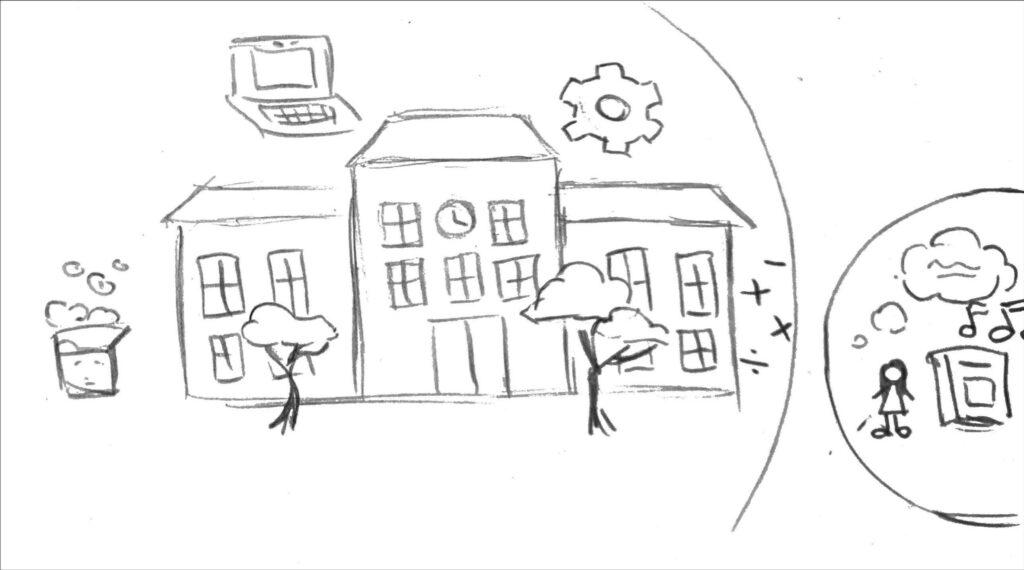Home to Apple, Google, Facebook and other successful tech companies, Silicon Valley is known as a leading region for tech innovation and development. Taking this into account, it’s no wonder that Saratoga, one of 13 cities within this world-renowned area, houses a vast majority of STEM-focused students — SHS is even ranked as the 11th best high school for STEM in California by Niche.
Yet there remains a small but mighty group of humanities students trying to navigate their way through this STEM-oriented climate. I am one of those students.
While I don’t have anything against STEM, I think STEM might have something against me. I’ve never done especially well in science, technology, engineering or math courses. Instead of staring at pages of incoherent numbers and variables, I’d much rather write a newspaper story for the Falcon.
However, my preferences aren’t shared by most of my peers — the vast majority of students here are interested in computer science and engineering. Because SHS course offerings are student-selected, there is a large disproportionality between the number of STEM and humanities courses available.
I’d like to see more humanities courses offered — of course, an equal number of humanities and STEM classes offered would not be feasible due to the skewed interest toward STEM, but a few more humanities offerings would be beneficial so students of both disciplines could have a more level playing field.
During course selection season, I procrastinated for weeks due to the overwhelming prominence of STEM courses over humanities courses. Given 21 days to choose my courses, I ended up deciding only two days before selections were due because of the tough lack of choices. I had trouble deciding on a math course that wasn’t too difficult to handle but still challenged me; I ended up choosing Precalculus, going with an easier math course to balance out other more rigorous courses like English 11 Honors and APUSH.
As STEM electives see increasing popularity, non-STEM classes face declining numbers: This year, there is only one Drama class for all four levels, and the specialized Journalism 1 course (previously an independent prerequisite for students going into newspaper or yearbook) was merged with yearbook this year and will be again next year.
Some non-STEM programs are at least holding steady. The music program has one of the largest freshman orchestras in years, totaling 52 students.
Still, if electives don’t have enough signups, they will die.
According to school registrar Robert Wise, the maximum number of humanities courses a student could take cumulatively in all four years at SHS is 19, whereas the maximum number of STEM courses is 32. (It is theoretically possible to take all the humanities courses or all the STEM courses and graduate.)
Additionally, at a competitive school like ours where students take the highest level courses offered to demonstrate academic rigor on college applications, humanities-focused students face a disadvantage: With an abundance of STEM-related AP or honors classes, humanities-based students simply don’t have the same opportunities as their peers at some other schools.
Where other schools make AP World History, AP Psychology and AP Language and Composition available to juniors, the maximum number of humanities AP/honors courses a student at SHS can take in their four years is eight. Meanwhile, the maximum number of AP/honors STEM courses is 12. For underclassmen at SHS, the only humanities AP classes available are AP European History and AP Art History.
I’ve had to seek humanities opportunities elsewhere — summer programs, community college classes and others — to satisfy my desire to learn more about them.
I’ve had some embarrassing instances where people, believing the stereotype of Silicon Valley kids as geniuses in STEM, mistook me for a STEM whiz.
Once, in an SAT preparation class, the math instructor was reviewing the class’s practice tests and asked the class which questions we got wrong and would like to review. Since only a few raised their hands to ask, I was reluctant to proclaim that I’m not the math genius Silicon Valley students are expected to be. The teacher commented that he wasn’t surprised students only needed to review a couple questions, given that Saratoga students often perform better in math than students from other areas.
Holding my packet with circled math questions to which I guessed at the answers, I thought: Well, this is awkward.
Through my past experiences, what I find most stressful about being a humanities-oriented student here is the external pressure to be adept at STEM subjects. Seeing my peers and even students in lower grade levels taking higher math courses has made me feel inadequate. From the social aspect, I’ve sometimes felt like the odd one out.
Seeing my peers intending to go down the STEM pathway, added with parental pressures and STEM’s growing industry, has created what seems like a choice between practicality (STEM) and passion (humanities).
Though I have yet to decide what field I want to go into for my future career, the external pressure to pursue STEM fields will not stop me from exploring my passion in the humanities. More humanities course offerings at SHS would be a great first step, but until then, I will continue searching for other means to explore the humanities and discover what specific area piques my interest.
Editor’s Note:
The statistics mentioned above regarding the maximum number of STEM/humanities courses students can take was generated with the assumptions that said student takes the maximum number of courses every semester (7), passes all classes, doesn’t worry about meeting college eligibility minimum requirements (UC/CSU, etc.) and is not enrolled in special education. For the purpose of calculations, humanities courses were defined as world languages, ethnic studies and art history courses. STEM courses include science, technology, engineering and math courses.
























